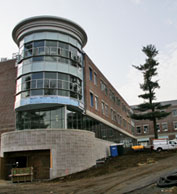STILLPOINT Archive: last updated 04/16/2008
The Ken Olsen Archives
Three museum-style exhibits in the new Ken Olsen Science Center's lobby--featuring technological artifacts, images and manuscripts--will highlight the themes of Ken Olsen's life and legacy, the technology of Digital Equipment Corporation (DEC) and the philosophy and distinguishing business practices of DEC.
While some of the pieces in the archives "aren't exactly eye candy," as one former DEC employee said, a closer look reveals that these sometimes-obscure pieces of metal point to the very human story of the technological revolution of the 20th century. For example, while core memory may seem like a confusing abacus to anyone other than a computer engineer, it tells the story of the concept behind computers as we know them today.
While in graduate school at MIT, Olsen worked in the Lincoln Labs on Project Whirlwind with Professors Jay Forrester and Bob Everett. Initially the objective of the project was to simulate and analyze flight functions. As it developed, the team needed a way to store and process information more efficiently. They created what came to be known as magnetic core memory, a precursor to today's RAM (random access memory). Core memory provided the basis for interactive computers, allowing Olsen to create his company--thus affecting generations of people, including former Microsoft CEO Bill Gates, who used a DEC computer for the first time when he was 13.
A letter addressed to Olsen from David Lee Fortune, a Wycliffe missionary, notes Olsen's impact on the "technological tribals of the asphalt jungles." He thanks Olsen for his "dedication, first to the Lord, second to quality equipment, and third to helping in the worldwide missionary movement with [his] wonderful machines." There are countless other letters of thanks and admiration in the archives from employees, friends and customers--all of which serve to give the intimidating wires, transistors and vacuum tubes a human face.
The PDP-1 Revolution
Ken Olsen and Harlan Anderson founded DEC with the dream of making computers accessible to everyone. The result was the Programmed Data Processor-1, introduced in 1961--the industry's first interactive computer. Weighing 1,200 pounds at an average cost of $120,000, the PDP-1 was by far the industry's smallest, cheapest computer at the time.
The PDP-1 was considered to be a very easy computer to use. One of the interactive capabilities was the first-ever computer game--SPACEWAR! This helped mark the PDP-1 as the first "fun" computer, laying the foundation for personal computers, workstations, word processing, and video games as we know them today.
